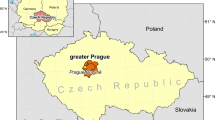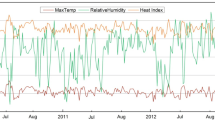Abstract
Mortality and morbidity indices are known to depend on changes in meteorological conditions. In Athens, severe adverse health effects following extreme heat conditions have been reported. The usefulness has been investigated of the complex thermohygrometric index (THI), a simple index based on maximum daily temperature and relative humidity, in predicting the health effects of specific meteorological conditions. The values of THI were found to correlate well with more complex bioclimatic indices; the THI could successfully replace temperature and humidity in predicting the daily number of deaths through multiple linear regression modelling. Thus the introduction of THI levels more than 28.5° C and between 26.5 and 28.5° C, through dummy variables, in a regression model explained 40% of the variability in the number of deaths during the months of July and August. During days with THI values less than 26.5° C the mean number of deaths was 33.5, compared to 41.8 when THI was between 26.5 and 28.5° C. The daily number of deaths increased to 108.2 when THI exceeded 28.5° C. From this study, the exact level of THI at which public health measures must be taken was not clear and more work is needed to identify it. However, given its simplicity, the use of THI for predicting meteorological conditions which are adverse to health would appear to be promising in preventive medicine and in health services planning.
Similar content being viewed by others
References
Besancenot JP (1990) Climate and tourism. Paris, Masson
Cena K, Clark JA (1981) Bioengineering, thermal physiology and comfort. Elsevier, Netherlands
Jones TS, Liang AP, Kilbourne EM, Galfin MR, Patriarca PA, Wassilak SG, Mullan RJ, Herrick RF, Donnell HD, Choi K, Thacker SB (1982) Morbidity and mortality associated with the July 1980 heat wave in St. Louis and Kansas City. J Am Med Assoc 247:3327–3331
Katsouyanni K, Trichopoulos D, Zavitsanos X, Touloumi G (1988) The 1987 Athens heat wave (letter). Lancet ii:573
Katsouyanni K, Pantazopoulou A, Touloumi G, Moustris K, Tselepidaki I, Asimakopoulos D, Poulopoulou G, Trichopoulos D (1993) Evidence for interaction between air pollution and high temperature in the causation of excess mortality. Arch Env Health 48:235–242
Kilbourne EM (1986) Illness due to thermal extremes. In: Last JM (ed) Maxcy-Rosenau public health and preventive medicine, 12th edn. Appleton-Century-Crofts, Norwalk, Connecticut; pp 703–710
Landsberg HE (1972) The assessment of human bioclimate: a limited review of physical parameters. WHO Technical note 123; p 36
Martinez BF, Annest JL, Kilbourne EM, Kirk ML, Lui KJ, Smith SM (1989) Geographic distribution of heat-related deaths among elderly persons. J Am Med Assoc 262:2246–2250
Moustris K, Poulopoulou C, Tselepidaki I (1990) Persistence of discomfort conditions during summer heat waves over Athens. Proceedings 3rd International Conference on Tourism and Health, Venice, Italy, Walter Pasini, Italy
National Observatory of Athens: Climatological Bulletin (Annual) Athens, Greece
Potter TD, Olsson LE (1989) Climate and tourist health. An overview of the world meteorological organization activities. Proceedings 2rd International Conference on Tourism and Health, Rimini, Italy, Walter Pasini, Italy
Rogot E, Padgett SJ (1976) Associations of coronary and stroke mortality with temperature and snowfall in selected areas of the United States. Am J Epidemiol. 103:565–575
Stewart SE, Gibson B, Land G, Rackers D, Donnell HD, Graumman A (1989) Heat related deaths: Missouri 1979–1988. Mort Morb Wkly Rep 38:437–439
Thom EC (1957) A new concept for cooling degree days. Air Condit Heating Ventil 54:73–80
Thom EC (1959) The discomfort index. Weatherwise (V) 20:57–60
Tselepidaki I, Santamouris M (1991) Statistical and persistance analysis of high summer ambient temperatures in Athens for cooling purposes. Energy and Buildings 17:243–251
United Kingdom, Air Ministry Meteorological Office (1962) Weather in the Mediterranean, vol 1. General meteorology. London, UK
Author information
Authors and Affiliations
Rights and permissions
About this article
Cite this article
Tselepidaki, I.G., Asimakopoulos, D.N., Katsouyanni, K. et al. The use of a complex thermohygrometric index in predicting adverse health effects in Athens. Int J Biometeorol 38, 194–198 (1995). https://doi.org/10.1007/BF01245388
Received:
Revised:
Accepted:
Issue Date:
DOI: https://doi.org/10.1007/BF01245388




